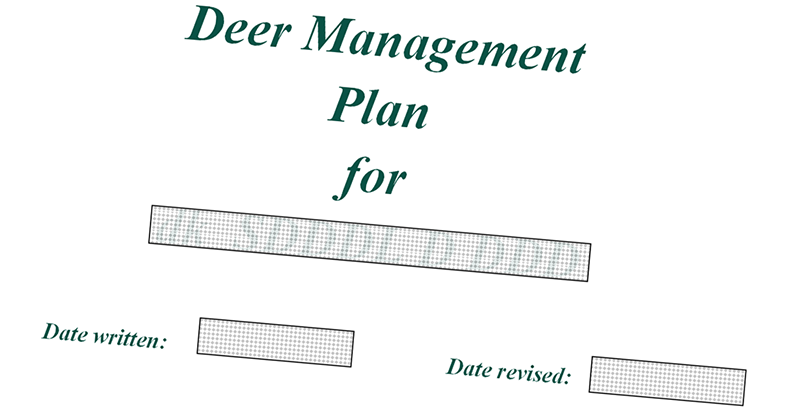
Introduction
The aim of this guide is to describe the use of a management plan as an aid to achieving
deer management objectives. This guide links to the Cull Planning, Population Dynamics and Population Modelling guides.
Why have a deer management plan?
A deer management plan (DMP) provides a practical and effective framework within which landowners, land managers and deer managers can acknowledge and then attempt to balance the differing uses demanded from an area of land. A central principle of all DMPs is that good deer management should aim to maintain healthy deer populations in balance with their environment.
Plans provide a basis for collecting and analysing necessary information which is then used to formulate management decisions. Planning and good communication between all involved in deer management avoids misunderstandings by ensuring transparency of:
- Management objectives
- Methods of achieving objectives
- Monitoring and recording achievements
- Ongoing reassessment of actions.
The process of developing the plan is in itself of value; it will encourage dialogue and highlight the range of expectations. It should therefore enable better collaboration and further understanding of the management challenges.
Who should be involved?
Contributions are required both from the landowner and all of the individuals who will deliver the actions identified; this should include both professional and recreational deer managers. Account should be taken of the views of those not directly involved with the preparation and delivery of the plans, particularly other land users such as farmers, foresters and gamekeepers, rural surveyors and wardens. Any relevant grant authorities should also be aware of the plan and might contribute to it. In some situations informing the wider community of the plan may identify legitimate constraints but can also provide an opportunity to promote the work of the deer manager.
Setting the boundaries
The size of area and the number of landholdings to be included will vary depending on the objectives of the plan. The differing scales of plans may be categorised as:
- Landscape scale DMP for very large areas (e.g. a woodland cluster or National Park) that applies similar objectives across disparate land holdings
- A Deer Management Group (DMG) plan
- Individual land ownership DMP
- A DMP that outlines a single approach for a single land use e.g. in connection with a forestry scheme.
What should be in a DMP?
Only use information that is relevant and useful (don’t pad it out but remember that some DMPs are intended for other readers). If it is helpful the plan may be split between those areas which are essentially background information and the parts of the plan which are active and constantly reviewed, such as the cull plan.
The diagram below outlines the planning process and may be used as an outline proforma; a more detailed proforma is available1. Use only those headings that are useful, focussing on objectives and how they can be met.
If the DMP includes a cull plan that is based on population numbers it is useful to present a simple population model that starts with an estimate of current numbers and applies annual estimates of culls and recruitment, to show how numbers will be modified to achieve objectives. See the Cull Planning guide.
It is essential to link the population model to habitat objectives to ensure sustainable management.
Objectives
It is important that management is carried out to meet objectives which should be:
Specific – Clear and understood by all concerned. Objectives may be simple( e.g. prevent habitat degradation) or more involved ( e.g. at the same time; minimising habitat and crop damage, maintaining herd numbers/health, improving quality, optimising income from culled deer)
Measurable – Capable of being monitored so that progress can be tracked.
Progress towards meeting objectives must be measured in a way that relates specifically to that objective, for instance: if reducing habitat impact is the objective, then simply monitoring whether cull targets have been met is not a useful way to judge success, it is impact levels that must be monitored, culling is just a means to an end.
Agreed – Stakeholders e.g. landowner, stalker, forester, gamekeeper, grant and statutory authorities(where applicable) should agree what the objectives are and how they will be achieved. For deer populations that move over a number of landholdings, especially for the larger species such as fallow, objectives are best set on a landscape scale through a DMG. Cull targets on each holding are agreed with the overall objective(s) in mind.
Realistic – Within the constraints of resources knowledge and time. There are usually limitations in terms of seasons, manpower, equipment and time. There may also be opportunities for improvements; objectives should be set with these in mind
Time based – Set over a realistic time period. It is often difficult to predict how long it will take to reach an objective, for instance reducing populations from very high levels can take a long time and involve a sustained effort to accomplish. In the case of multiple objectives some will be reached before others.
Further Info
1 A Guide to writing Deer Management plans and a Plan pro-forma will be found in the Associated Information section of these guides.